外研版(2019)选择性必修 第一册Unit 1 Laugh out loud! Using Language名师教学设计
文档属性
| 名称 | 外研版(2019)选择性必修 第一册Unit 1 Laugh out loud! Using Language名师教学设计 |
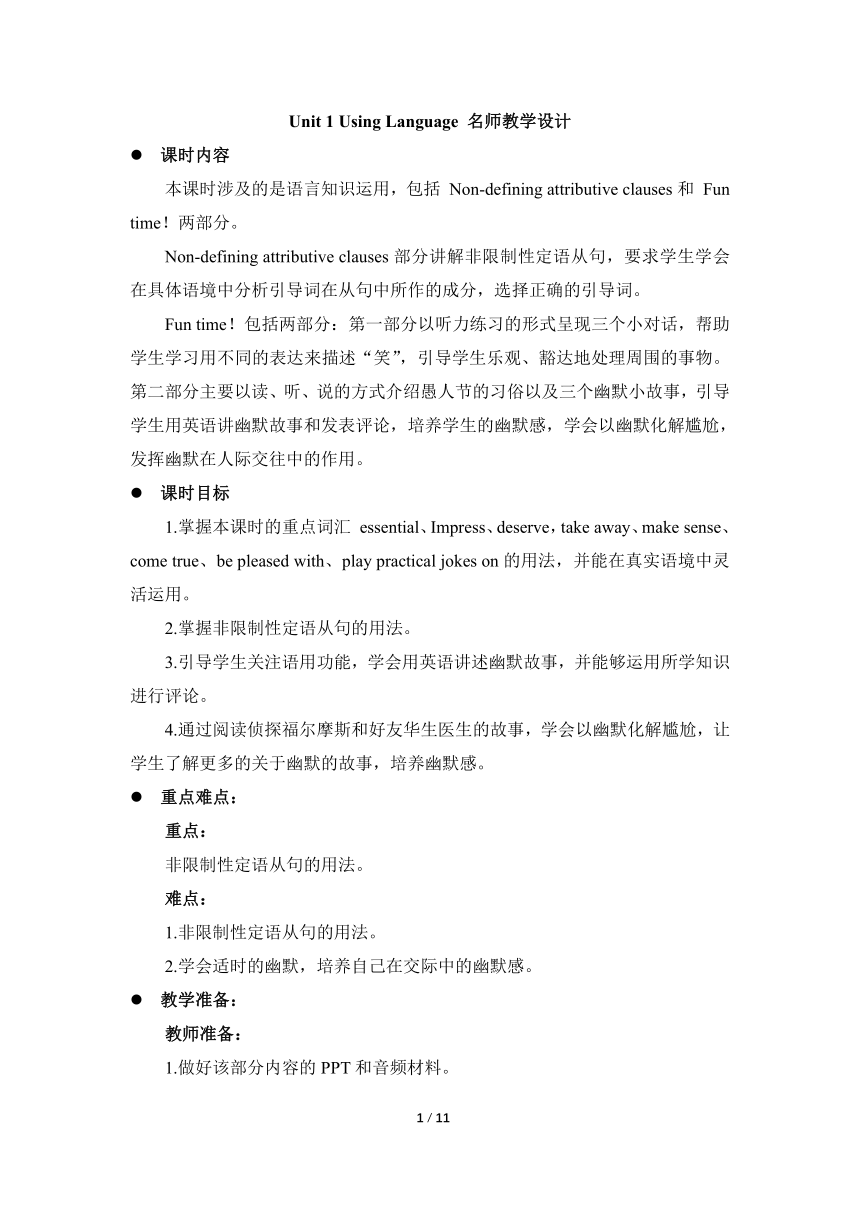
|
|
| 格式 | docx | ||
| 文件大小 | 2.3MB | ||
| 资源类型 | 教案 | ||
| 版本资源 | 外研版(2019) | ||
| 科目 | 英语 | ||
| 更新时间 | 2023-03-02 10:49:23 | ||
图片预览

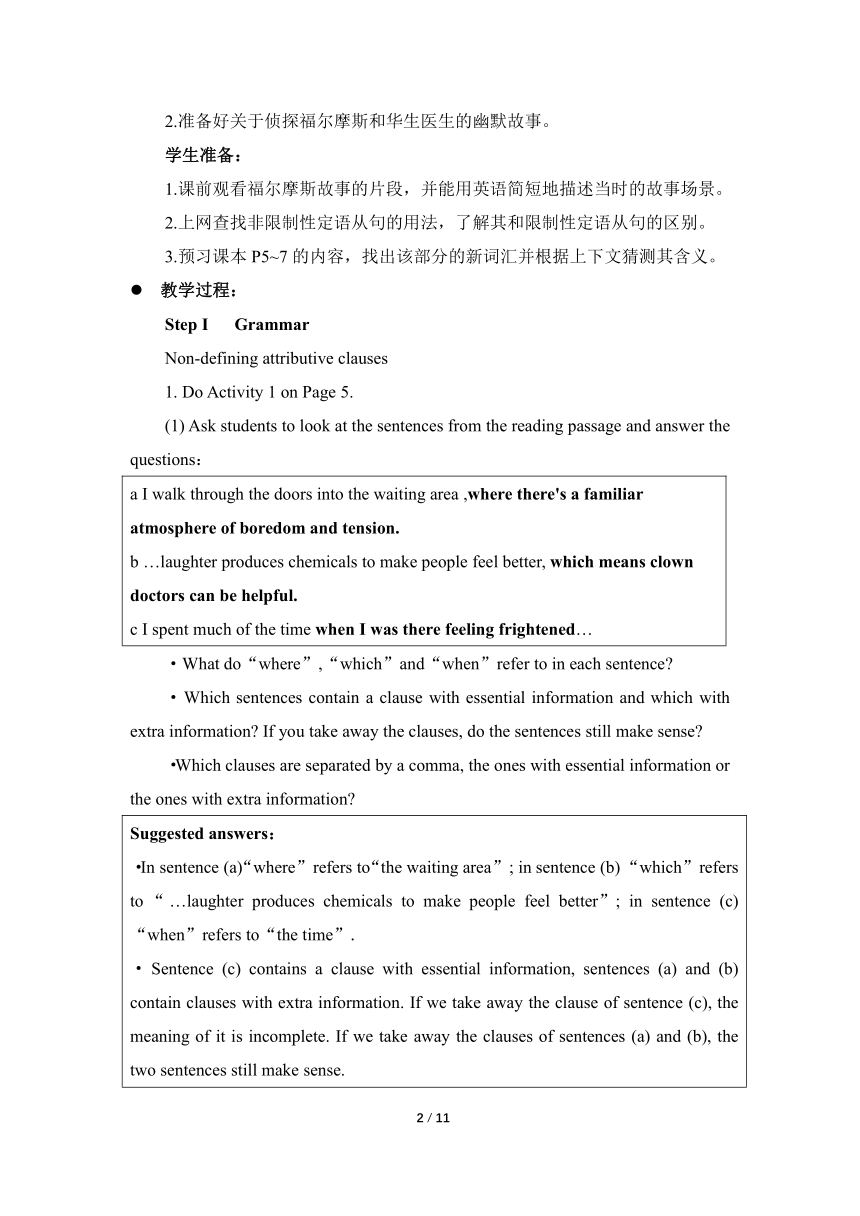
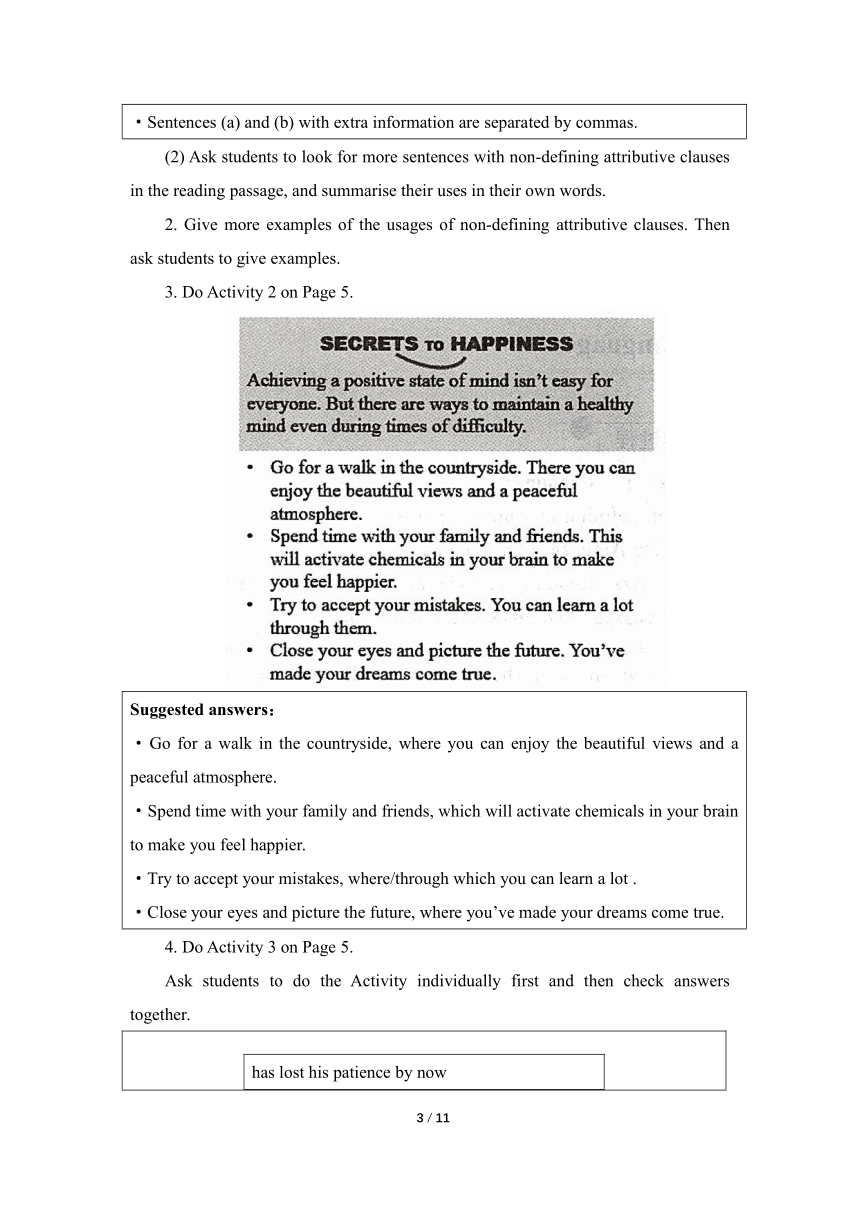
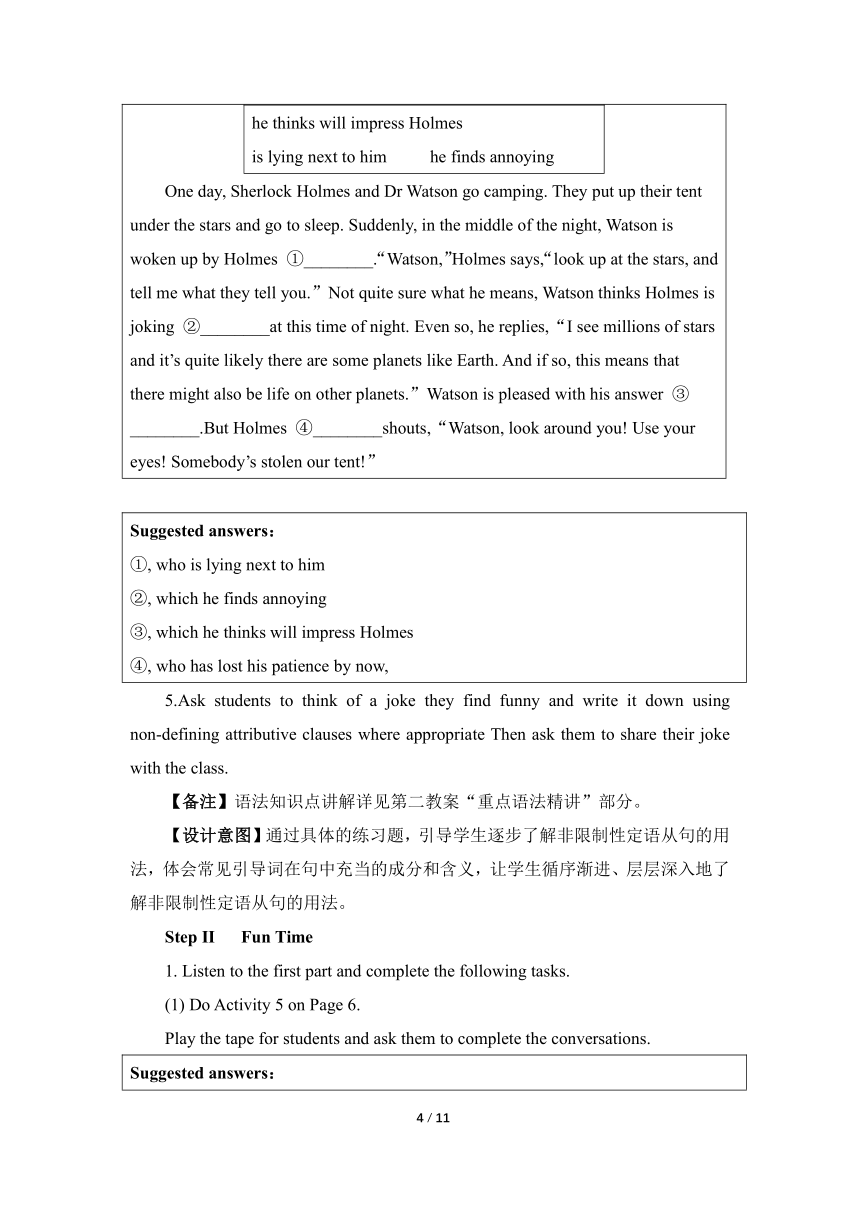
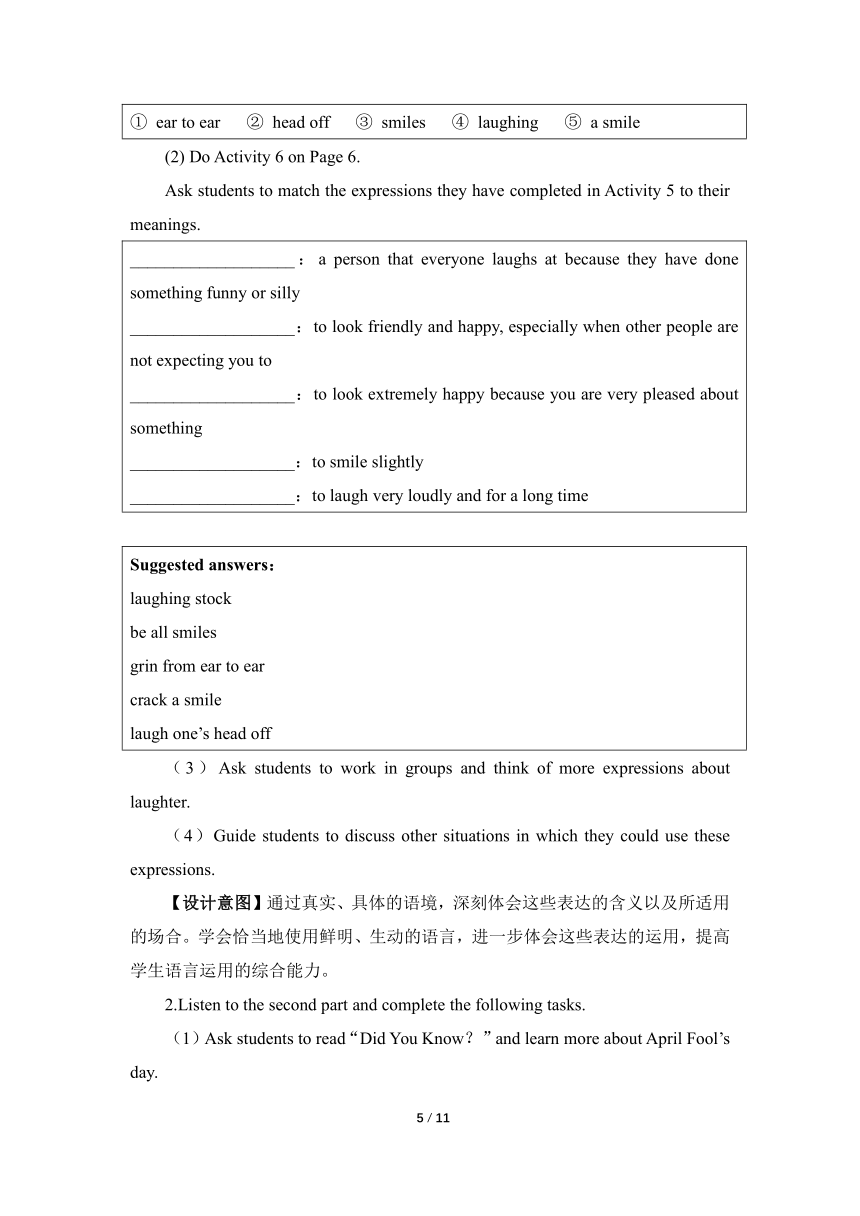
文档简介
Unit 1 Using Language 名师教学设计
课时内容
本课时涉及的是语言知识运用,包括 Non-defining attributive clauses和 Fun time!两部分。
Non-defining attributive clauses部分讲解非限制性定语从句,要求学生学会在具体语境中分析引导词在从句中所作的成分,选择正确的引导词。
Fun time!包括两部分:第一部分以听力练习的形式呈现三个小对话,帮助学生学习用不同的表达来描述“笑”,引导学生乐观、豁达地处理周围的事物。第二部分主要以读、听、说的方式介绍愚人节的习俗以及三个幽默小故事,引导学生用英语讲幽默故事和发表评论,培养学生的幽默感,学会以幽默化解尴尬,发挥幽默在人际交往中的作用。
课时目标
1.掌握本课时的重点词汇 essential、Impress、deserve,take away、make sense、come true、be pleased with、play practical jokes on的用法,并能在真实语境中灵活运用。
2.掌握非限制性定语从句的用法。
3.引导学生关注语用功能,学会用英语讲述幽默故事,并能够运用所学知识进行评论。
4.通过阅读侦探福尔摩斯和好友华生医生的故事,学会以幽默化解尴尬,让学生了解更多的关于幽默的故事,培养幽默感。
重点难点:
重点:
非限制性定语从句的用法。
难点:
1.非限制性定语从句的用法。
2.学会适时的幽默,培养自己在交际中的幽默感。
教学准备:
教师准备:
1.做好该部分内容的PPT和音频材料。
2.准备好关于侦探福尔摩斯和华生医生的幽默故事。
学生准备:
1.课前观看福尔摩斯故事的片段,并能用英语简短地描述当时的故事场景。
2.上网查找非限制性定语从句的用法,了解其和限制性定语从句的区别。
3.预习课本P5~7的内容,找出该部分的新词汇并根据上下文猜测其含义。
教学过程:
Step Ⅰ Grammar
Non-defining attributive clauses
1. Do Activity 1 on Page 5.
(1) Ask students to look at the sentences from the reading passage and answer the questions:
a I walk through the doors into the waiting area ,where there's a familiar atmosphere of boredom and tension. b …laughter produces chemicals to make people feel better, which means clown doctors can be helpful. c I spent much of the time when I was there feeling frightened…
·What do“where”,“which”and“when”refer to in each sentence
·Which sentences contain a clause with essential information and which with extra information If you take away the clauses, do the sentences still make sense
·Which clauses are separated by a comma, the ones with essential information or the ones with extra information
Suggested answers: ·In sentence (a)“where”refers to“the waiting area”; in sentence (b) “which”refers to“…laughter produces chemicals to make people feel better”; in sentence (c) “when”refers to“the time”. ·Sentence (c) contains a clause with essential information, sentences (a) and (b) contain clauses with extra information. If we take away the clause of sentence (c), the meaning of it is incomplete. If we take away the clauses of sentences (a) and (b), the two sentences still make sense. ·Sentences (a) and (b) with extra information are separated by commas.
(2) Ask students to look for more sentences with non-defining attributive clauses in the reading passage, and summarise their uses in their own words.
2. Give more examples of the usages of non-defining attributive clauses. Then ask students to give examples.
3. Do Activity 2 on Page 5.
Suggested answers: ·Go for a walk in the countryside, where you can enjoy the beautiful views and a peaceful atmosphere. ·Spend time with your family and friends, which will activate chemicals in your brain to make you feel happier. ·Try to accept your mistakes, where/through which you can learn a lot . ·Close your eyes and picture the future, where you’ve made your dreams come true.
4. Do Activity 3 on Page 5.
Ask students to do the Activity individually first and then check answers together.
has lost his patience by now he thinks will impress Holmes is lying next to him he finds annoying
One day, Sherlock Holmes and Dr Watson go camping. They put up their tent under the stars and go to sleep. Suddenly, in the middle of the night, Watson is woken up by Holmes ①________.“Watson,”Holmes says,“look up at the stars, and tell me what they tell you.”Not quite sure what he means, Watson thinks Holmes is joking ②________at this time of night. Even so, he replies,“I see millions of stars and it’s quite likely there are some planets like Earth. And if so, this means that there might also be life on other planets.”Watson is pleased with his answer ③________.But Holmes ④________shouts,“Watson, look around you! Use your eyes! Somebody’s stolen our tent!”
Suggested answers: ①, who is lying next to him ②, which he finds annoying ③, which he thinks will impress Holmes ④, who has lost his patience by now,
5.Ask students to think of a joke they find funny and write it down using non-defining attributive clauses where appropriate Then ask them to share their joke with the class.
【备注】语法知识点讲解详见第二教案“重点语法精讲”部分。
【设计意图】通过具体的练习题,引导学生逐步了解非限制性定语从句的用法,体会常见引导词在句中充当的成分和含义,让学生循序渐进、层层深入地了解非限制性定语从句的用法。
Step Ⅱ Fun Time
1. Listen to the first part and complete the following tasks.
(1) Do Activity 5 on Page 6.
Play the tape for students and ask them to complete the conversations.
Suggested answers: ① ear to ear ② head off ③ smiles ④ laughing ⑤ a smile
(2) Do Activity 6 on Page 6.
Ask students to match the expressions they have completed in Activity 5 to their meanings.
___________________:a person that everyone laughs at because they have done something funny or silly ___________________:to look friendly and happy, especially when other people are not expecting you to ___________________:to look extremely happy because you are very pleased about something ___________________:to smile slightly ___________________:to laugh very loudly and for a long time
Suggested answers: laughing stock be all smiles grin from ear to ear crack a smile laugh one’s head off
(3)Ask students to work in groups and think of more expressions about laughter.
(4)Guide students to discuss other situations in which they could use these expressions.
【设计意图】通过真实、具体的语境,深刻体会这些表达的含义以及所适用的场合。学会恰当地使用鲜明、生动的语言,进一步体会这些表达的运用,提高学生语言运用的综合能力。
2.Listen to the second part and complete the following tasks.
(1)Ask students to read“Did You Know?”and learn more about April Fool’s day.
(2) Ask students to listen to the radio programme and choose the pictures mentioned.
Suggested answers: a c d
(3) Play the tape again and ask the students to complete the notes.
Joke 1 ·Year:1698 ·Main story:A newsletter reported people going to watch ①___________________at the Tower of London. The joke was played on visitors throughout the ②___________________. Joke 2 ·Year:③___________________ ·Main story:The ④___________________introduced an invention called “Smellovision”. It allowed ⑤___________________over the airwaves. Joke 3 ·Year:⑥___________________ ·Main story:A news programme told viewers that the spaghetti trees in Switzerland were having ⑦___________________.
Suggested answers: ①“the washing of the lions” ② 18th and 19th centuries ③ 1965 ④ BBC News Channel ⑤ smells to be carried ⑥ 1957 ⑦ a really good harvest
(4) Ask students to discuss which of the practical jokes they think is funny and why.
(5) Ask students to complete the boxes with expressions from the radio programme.
·Let’s start with… ·It’s a good one!
·I don’t get it. ·That’s so funny!
·Now, my favourite one… ·I can imagine
Telling a story Making comments
Suggested answers: Telling a storyMaking commentsLet’s start with…It's a good one!Now, my favourite one…I don’t get it.That’s so funny!I can imagine!
(6)Ask students to work in pairs to tell each other a funny story and make comments using the expressions above.And then ask them to give feedback on each other’s stories and help their partner to improve theirs.
【设计意图】通过阅读了解愚人节的文化内涵;通过听广播节目,完成下列任务:第一次听录音,要求将录音中听到的图片选择出来;第二次听录音,难度有所增加,要求在听的同时写出关键信息。学生在听完录音后,让学生自已创设语境作对话练习,在语言输入的基础上进行语言输出,进一步掌握所学内容,提高语言的应用能力。
Step Ⅲ Exercises
Choose the best answers
① I lost a book, ______________I can’t remember now. A. whose titleB. its titleC. the title of itD. the title of that
② Last summer we visited the West Lake, ______________ Hangzhou is famous in the world. A. for whichB. for thatC. in whichD. what
③ This machine, ______________for many years, is still working perfectly. A. after which I have looked B. which I have looked after C. that I have looked after D. I have looked after ④ He is working hard, ______________will make him pass the final exam. A. thatB. whichC. for whichD. who
⑤ My neighbours used to give me a hand in time of trouble, ______________ was very kind of them. A. whoB. whichC. thatD. it
⑥ I shall never forget those years ______________ I lived on the farm with farmers, ______________ has a great effect on my life. A. when;whoB. that;whichC. which;thatD. when;which
⑦ The clever boy made a hole in the wall, ______________ he could see ______________ was going on inside house. A. which;whatB. through which;whatC. through that;whatD. what;that
⑧ I have bought two ball pens, ______________ writes well. A. none of themB. neither of themC. neither of whichD. none of which
Suggested answers: ①A whose title引导非限制性定语从句,whose title也可以用 the title of which来替换。 ②A for which引导定语从句,使用介词for,是因为从句中的固定短语 be famous for…意为“以……而闻名”。 ③B which I have looked after构成一个非限制性定语从句。 ④B 非限制性定语从句常用 which引导,which指代前面整句话的含义。 ⑤B 非限制性定语从句常用 which引导,which指代前面整句话的含义。 ⑥D years是表示时间的名词,后面的定语从句中句子结构完整,故用when在从句中作时间状语。第二个空用 which引导一个非限制性定语从句,指代前一句话的内容。 ⑦B through which引导定语从句,through which即through the hole,在从句中作状语。what引导的是宾语从句,what在从句中作主语。 ⑧C 先行词是 two ball pens指物,引导词应用which,表示两者之间的否定应用 neither of。
【设计意图】通过该练习,引导学生了解非限制性定语从句的基本用法以及引导词的选择,锻炼学生分析句子结构、选用恰当的引导词的能力,以此提高学生分析问题、解决问题的能力。
Step IV Summing up
总结非限制性定语从句的含义和用法,并注意该部分新词汇的运用。
Step V Homework
1. Give students some examples to fill in the blanks with non-defining attributive clauses.
2. Master the usages of the new vocabulary.
板书设计:
Unit 1 Laugh out loud Period II Using language I Grammar Non-defining attributive clauses 1. Do Activity 1 on Page 5. 2. Give examples of the usages of non-defining attributive clauses. 3. Do Activity 2 on Page 5. 4. Do activity 3 on Page 5. 5. Think of a joke using non-defining attributive clauses. Ⅱ. Fun time 1. Listen to the first part and complete the following tasks. (1) Do Activity 5 on Page 6. (2) Do Activity 6 on Page 6. (3) Work in groups and think of more expressions about laughter. (4) Discuss other situations using these expressions. 2. Listen to the second part and complete the following tasks. (1) Read “Did You Know ”and learn more about April Fool’s Day. (2) Listen and choose the pictures mentioned. (3) Listen again and complete the notes. (4) Discuss which of the practical jokes is funny and why. (5) Complete the boxes with expressions from the radio programme. (6) Tell each other a funny story and make comments. Ⅲ. Exercises IV. Summing up V. Homework
1 / 12
课时内容
本课时涉及的是语言知识运用,包括 Non-defining attributive clauses和 Fun time!两部分。
Non-defining attributive clauses部分讲解非限制性定语从句,要求学生学会在具体语境中分析引导词在从句中所作的成分,选择正确的引导词。
Fun time!包括两部分:第一部分以听力练习的形式呈现三个小对话,帮助学生学习用不同的表达来描述“笑”,引导学生乐观、豁达地处理周围的事物。第二部分主要以读、听、说的方式介绍愚人节的习俗以及三个幽默小故事,引导学生用英语讲幽默故事和发表评论,培养学生的幽默感,学会以幽默化解尴尬,发挥幽默在人际交往中的作用。
课时目标
1.掌握本课时的重点词汇 essential、Impress、deserve,take away、make sense、come true、be pleased with、play practical jokes on的用法,并能在真实语境中灵活运用。
2.掌握非限制性定语从句的用法。
3.引导学生关注语用功能,学会用英语讲述幽默故事,并能够运用所学知识进行评论。
4.通过阅读侦探福尔摩斯和好友华生医生的故事,学会以幽默化解尴尬,让学生了解更多的关于幽默的故事,培养幽默感。
重点难点:
重点:
非限制性定语从句的用法。
难点:
1.非限制性定语从句的用法。
2.学会适时的幽默,培养自己在交际中的幽默感。
教学准备:
教师准备:
1.做好该部分内容的PPT和音频材料。
2.准备好关于侦探福尔摩斯和华生医生的幽默故事。
学生准备:
1.课前观看福尔摩斯故事的片段,并能用英语简短地描述当时的故事场景。
2.上网查找非限制性定语从句的用法,了解其和限制性定语从句的区别。
3.预习课本P5~7的内容,找出该部分的新词汇并根据上下文猜测其含义。
教学过程:
Step Ⅰ Grammar
Non-defining attributive clauses
1. Do Activity 1 on Page 5.
(1) Ask students to look at the sentences from the reading passage and answer the questions:
a I walk through the doors into the waiting area ,where there's a familiar atmosphere of boredom and tension. b …laughter produces chemicals to make people feel better, which means clown doctors can be helpful. c I spent much of the time when I was there feeling frightened…
·What do“where”,“which”and“when”refer to in each sentence
·Which sentences contain a clause with essential information and which with extra information If you take away the clauses, do the sentences still make sense
·Which clauses are separated by a comma, the ones with essential information or the ones with extra information
Suggested answers: ·In sentence (a)“where”refers to“the waiting area”; in sentence (b) “which”refers to“…laughter produces chemicals to make people feel better”; in sentence (c) “when”refers to“the time”. ·Sentence (c) contains a clause with essential information, sentences (a) and (b) contain clauses with extra information. If we take away the clause of sentence (c), the meaning of it is incomplete. If we take away the clauses of sentences (a) and (b), the two sentences still make sense. ·Sentences (a) and (b) with extra information are separated by commas.
(2) Ask students to look for more sentences with non-defining attributive clauses in the reading passage, and summarise their uses in their own words.
2. Give more examples of the usages of non-defining attributive clauses. Then ask students to give examples.
3. Do Activity 2 on Page 5.
Suggested answers: ·Go for a walk in the countryside, where you can enjoy the beautiful views and a peaceful atmosphere. ·Spend time with your family and friends, which will activate chemicals in your brain to make you feel happier. ·Try to accept your mistakes, where/through which you can learn a lot . ·Close your eyes and picture the future, where you’ve made your dreams come true.
4. Do Activity 3 on Page 5.
Ask students to do the Activity individually first and then check answers together.
has lost his patience by now he thinks will impress Holmes is lying next to him he finds annoying
One day, Sherlock Holmes and Dr Watson go camping. They put up their tent under the stars and go to sleep. Suddenly, in the middle of the night, Watson is woken up by Holmes ①________.“Watson,”Holmes says,“look up at the stars, and tell me what they tell you.”Not quite sure what he means, Watson thinks Holmes is joking ②________at this time of night. Even so, he replies,“I see millions of stars and it’s quite likely there are some planets like Earth. And if so, this means that there might also be life on other planets.”Watson is pleased with his answer ③________.But Holmes ④________shouts,“Watson, look around you! Use your eyes! Somebody’s stolen our tent!”
Suggested answers: ①, who is lying next to him ②, which he finds annoying ③, which he thinks will impress Holmes ④, who has lost his patience by now,
5.Ask students to think of a joke they find funny and write it down using non-defining attributive clauses where appropriate Then ask them to share their joke with the class.
【备注】语法知识点讲解详见第二教案“重点语法精讲”部分。
【设计意图】通过具体的练习题,引导学生逐步了解非限制性定语从句的用法,体会常见引导词在句中充当的成分和含义,让学生循序渐进、层层深入地了解非限制性定语从句的用法。
Step Ⅱ Fun Time
1. Listen to the first part and complete the following tasks.
(1) Do Activity 5 on Page 6.
Play the tape for students and ask them to complete the conversations.
Suggested answers: ① ear to ear ② head off ③ smiles ④ laughing ⑤ a smile
(2) Do Activity 6 on Page 6.
Ask students to match the expressions they have completed in Activity 5 to their meanings.
___________________:a person that everyone laughs at because they have done something funny or silly ___________________:to look friendly and happy, especially when other people are not expecting you to ___________________:to look extremely happy because you are very pleased about something ___________________:to smile slightly ___________________:to laugh very loudly and for a long time
Suggested answers: laughing stock be all smiles grin from ear to ear crack a smile laugh one’s head off
(3)Ask students to work in groups and think of more expressions about laughter.
(4)Guide students to discuss other situations in which they could use these expressions.
【设计意图】通过真实、具体的语境,深刻体会这些表达的含义以及所适用的场合。学会恰当地使用鲜明、生动的语言,进一步体会这些表达的运用,提高学生语言运用的综合能力。
2.Listen to the second part and complete the following tasks.
(1)Ask students to read“Did You Know?”and learn more about April Fool’s day.
(2) Ask students to listen to the radio programme and choose the pictures mentioned.
Suggested answers: a c d
(3) Play the tape again and ask the students to complete the notes.
Joke 1 ·Year:1698 ·Main story:A newsletter reported people going to watch ①___________________at the Tower of London. The joke was played on visitors throughout the ②___________________. Joke 2 ·Year:③___________________ ·Main story:The ④___________________introduced an invention called “Smellovision”. It allowed ⑤___________________over the airwaves. Joke 3 ·Year:⑥___________________ ·Main story:A news programme told viewers that the spaghetti trees in Switzerland were having ⑦___________________.
Suggested answers: ①“the washing of the lions” ② 18th and 19th centuries ③ 1965 ④ BBC News Channel ⑤ smells to be carried ⑥ 1957 ⑦ a really good harvest
(4) Ask students to discuss which of the practical jokes they think is funny and why.
(5) Ask students to complete the boxes with expressions from the radio programme.
·Let’s start with… ·It’s a good one!
·I don’t get it. ·That’s so funny!
·Now, my favourite one… ·I can imagine
Telling a story Making comments
Suggested answers: Telling a storyMaking commentsLet’s start with…It's a good one!Now, my favourite one…I don’t get it.That’s so funny!I can imagine!
(6)Ask students to work in pairs to tell each other a funny story and make comments using the expressions above.And then ask them to give feedback on each other’s stories and help their partner to improve theirs.
【设计意图】通过阅读了解愚人节的文化内涵;通过听广播节目,完成下列任务:第一次听录音,要求将录音中听到的图片选择出来;第二次听录音,难度有所增加,要求在听的同时写出关键信息。学生在听完录音后,让学生自已创设语境作对话练习,在语言输入的基础上进行语言输出,进一步掌握所学内容,提高语言的应用能力。
Step Ⅲ Exercises
Choose the best answers
① I lost a book, ______________I can’t remember now. A. whose titleB. its titleC. the title of itD. the title of that
② Last summer we visited the West Lake, ______________ Hangzhou is famous in the world. A. for whichB. for thatC. in whichD. what
③ This machine, ______________for many years, is still working perfectly. A. after which I have looked B. which I have looked after C. that I have looked after D. I have looked after ④ He is working hard, ______________will make him pass the final exam. A. thatB. whichC. for whichD. who
⑤ My neighbours used to give me a hand in time of trouble, ______________ was very kind of them. A. whoB. whichC. thatD. it
⑥ I shall never forget those years ______________ I lived on the farm with farmers, ______________ has a great effect on my life. A. when;whoB. that;whichC. which;thatD. when;which
⑦ The clever boy made a hole in the wall, ______________ he could see ______________ was going on inside house. A. which;whatB. through which;whatC. through that;whatD. what;that
⑧ I have bought two ball pens, ______________ writes well. A. none of themB. neither of themC. neither of whichD. none of which
Suggested answers: ①A whose title引导非限制性定语从句,whose title也可以用 the title of which来替换。 ②A for which引导定语从句,使用介词for,是因为从句中的固定短语 be famous for…意为“以……而闻名”。 ③B which I have looked after构成一个非限制性定语从句。 ④B 非限制性定语从句常用 which引导,which指代前面整句话的含义。 ⑤B 非限制性定语从句常用 which引导,which指代前面整句话的含义。 ⑥D years是表示时间的名词,后面的定语从句中句子结构完整,故用when在从句中作时间状语。第二个空用 which引导一个非限制性定语从句,指代前一句话的内容。 ⑦B through which引导定语从句,through which即through the hole,在从句中作状语。what引导的是宾语从句,what在从句中作主语。 ⑧C 先行词是 two ball pens指物,引导词应用which,表示两者之间的否定应用 neither of。
【设计意图】通过该练习,引导学生了解非限制性定语从句的基本用法以及引导词的选择,锻炼学生分析句子结构、选用恰当的引导词的能力,以此提高学生分析问题、解决问题的能力。
Step IV Summing up
总结非限制性定语从句的含义和用法,并注意该部分新词汇的运用。
Step V Homework
1. Give students some examples to fill in the blanks with non-defining attributive clauses.
2. Master the usages of the new vocabulary.
板书设计:
Unit 1 Laugh out loud Period II Using language I Grammar Non-defining attributive clauses 1. Do Activity 1 on Page 5. 2. Give examples of the usages of non-defining attributive clauses. 3. Do Activity 2 on Page 5. 4. Do activity 3 on Page 5. 5. Think of a joke using non-defining attributive clauses. Ⅱ. Fun time 1. Listen to the first part and complete the following tasks. (1) Do Activity 5 on Page 6. (2) Do Activity 6 on Page 6. (3) Work in groups and think of more expressions about laughter. (4) Discuss other situations using these expressions. 2. Listen to the second part and complete the following tasks. (1) Read “Did You Know ”and learn more about April Fool’s Day. (2) Listen and choose the pictures mentioned. (3) Listen again and complete the notes. (4) Discuss which of the practical jokes is funny and why. (5) Complete the boxes with expressions from the radio programme. (6) Tell each other a funny story and make comments. Ⅲ. Exercises IV. Summing up V. Homework
1 / 12
